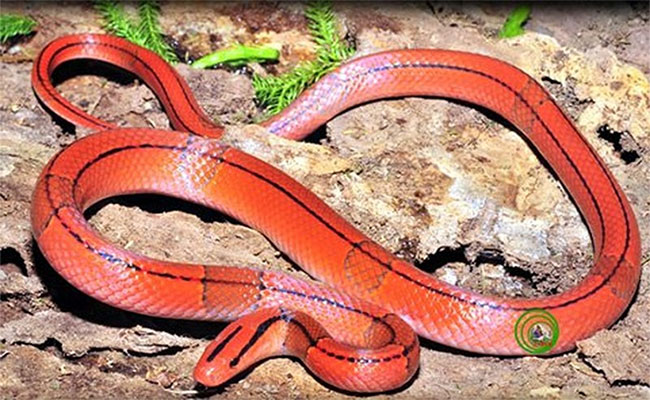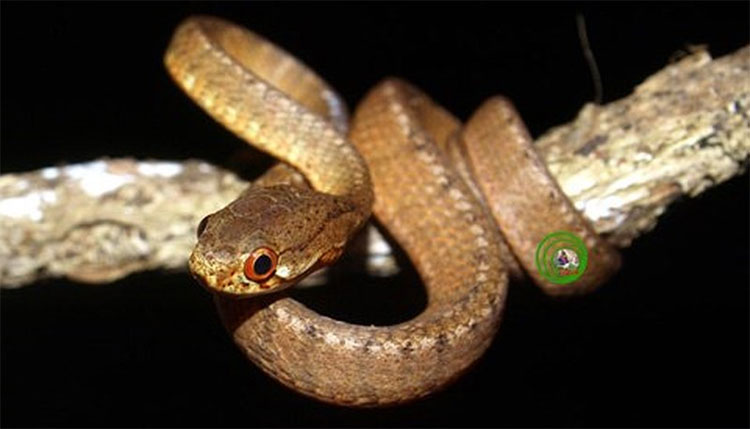7 snakes look scary ... but harmless to humans
Snakes are reptiles, cold-blooded, and in the same class as scaly animals like lizards and geckos, but they have teeth because people often think that snakes are very toxic. Scientific information provided by researchers shows that some of the following snake species are completely harmless to humans:
Red spot stripes

Oreocryptophis porphyraceus, red spotted stripe snake. This species is considered one of the most sprawling snakes in Vietnam and is also a species that lives in places close to our roof. They often eat at the edge of the forest along streams in the high mountains.
They like to operate early in the morning or sunset. Their main food is amphibians and small rodents. Red-spotted striped snakes lay about 2 - 7 eggs. It is because of their brilliant beauty and completely harmless to humans that they have been hunted aggressively for trade and breeding. This species has been included in the Vietnam Red Book.
Cloudy cobra

Pareas carinatus In Vinh Cuu Nature Reserve when the nighttime temperature drops, the human body starts to feel the coldness of the night fog falling when it crawls out of the cave where it hides during the day, to go for food.
The frog species Rahacophorus and the small frogs will be their good prey. This species is very rare in the daytime but it is easy to identify this nontoxic snake in the night with a light brown scales, the scales close to the dark brown belly, the outer edge of the eyes glowing red when the light reflected in the night dark. Cloudy serpent is a small, shy, large-sized snake, but the number of individuals of this species is not much in nature.
Milk snake

The appearance is quite similar to the red poisonous coral snake, but the milk snake is completely harmless. To distinguish milk snake and red coral, it is based on the color of the body: the red stripe next to the black stripe is the milk snake, the red stripe next to the yellow stripe is the red coral snake.
Their name comes from a legend that suggests that this snake is known to suck milk directly from cow's breast. Milk snakes live mainly in Honduras and Nicaragua in Central America. Milk snakes are cultured by some young people and cost up to millions each.
Snake Leptotyphlops carlae
In 2008, scientists found the world's smallest known snake, which can be curled up in coins, about 10cm long, no different from noodles, with the scientific name Leptotyphlops carlae. According to American biologist Blair Hedges at Penn State University, the discoverer of this type of snake said that this is the smallest snake ever discovered by humans, it mainly eats ants, larvae and Termites to survive. Each time only 1-2 children.
Jade barrier

Boiga jaspidea jade fence. The title of Beauty Queen of snakes will certainly be for this species because of the colors and patterns on its body that are made up of harmonious makeup. In the dark, the reflection of the stained layers by the flash image made it stand out. Although it is a non-poisonous snake, it has the ability to mimic some venomous snakes when threatened by bulging the output to scare the enemy and make threatening sounds to find a way to hide.
Chrysopelea ornata

This small snake, about 130cm long, has a green head with black markings. This small and shy snake often uses a method of hiding "the book of the noble books" when it comes to an enemy this is probably their most effective method because of 'knowing yourself weak'. They are a daytime feeding species, the main food known only as small lizards that hide from vegetation. Occasionally, they went into the wild houses or houses close to the edge of the forest to catch Hemidactylus geckos. Occasionally people have the opportunity to see it strongly showy when meeting the weaker ones.
Small flower snake Rhabdophis subminiatus

Brilliant colors in the head and neck not only add to the erotic beauty of the " solid " guys in mating season to attract mates, but also help it to threaten enemies because of this "death" color . . They may be harmless to humans and some other warm-blooded animals but they are nightmares for amphibian cold-blooded species in the forests. This species is often distributed at low altitudes and the darkness always accompanies it in finding food and finding partners during mating season. Recently scientists discovered that this species has toxic accumulation in the body when they eat poisonous species.
- Flaming red snake Vietnam makes people play hard to hunt
- Scary secrets of snakes that until now science revealed
- How to kill the scary midnight of Indian poisonous snakes
- 'Terrifying beauty' of colorful snakes
- Close up of snakes specializing in biting people when they sleep, causing a terrible nightmare in Australia
- Snakes swallow 4 eggs, have trouble, buckling vomiting
- Scary people with animals eat themselves
- Poisonous snakes in Vietnam
- The truth about 11 extremely poisonous snakes in the world
- Strange little known about snakes
- Find a new snake, but no one can find it
- Mysterious answers about snakes and canines
 Animal 'suffering' after hibernation
Animal 'suffering' after hibernation Why do goats climb well?
Why do goats climb well? Scientists were surprised to see chimpanzees eating turtles
Scientists were surprised to see chimpanzees eating turtles Giant catfish died deadly due to drought in Thailand
Giant catfish died deadly due to drought in Thailand